Indian Institue of Management 2008 M.B.A Business Administration CAT - Question Paper
AtyPI REP SET-222
EXPLANATORY ANSWERS SECTION - I PS
1. Let S = 1 + 2 + ... + 40.
i.e., 1 + 2 + a + b + ... + 40 = S After step I:
1 +2 + .... + (a + b 1) + ... + 40 = S 1
Hence, after each step the total reduces by 1. Continuing this way after 39 setps we will be
. 40 x 41
left with the number S - 39 = 2 - 39 = 781
Hence, [3].
2. 72008 = (74)502 = (2401)502 (24 01)502 = (24 00 + 1)502
= (2400)502 + 502Cj x 24 0 0 + .... + 502C501 x 2400 + 1502 Every term in the above expans except, 1501 is divisible by 100. ... 72008 = k x 100 + 1 Thus, 72008 ends with 01. Hence, [3].
3. Let the consecutive roots be (n - 1), n and n + 1 Now, b = n(n - 1) + n(n + 1) + (n - 1)(n + 1)
= 3n2 - 1
Since, 3n2 > 0 minimum value of b = 3 x 02 - 1 = -1 Hence, [2].
4. From the data, we get a table
|
Quantity of Rice in the shop |
Quantity of Rice bought |
Quantity Left |
|
x |
fi * 1) |
x 1 2 2 |
|
x 1 |
f x 11 + 1 |
x 3 |
|
2 2 |
4 4) 2 |
4 4 |
|
x 3 |
f x 31 + 1 |
x 7 |
|
4 4 |
8 8) 2 |
8 8 |
x 7
- - - = 0 x = 7
8 8
Now, 5 < 7 < 8 Hence, [2].
5. Given f(x) = ax2 + bx + c (a * 0).
REP*
SET-222
3 is a root of f(x)
9a + 3b + c = 0 --- (i)
Also, f(5) = -3f(2).
25a + 5b + c = -3 (4a + 2b + c)
= -12a - 6b - 3c
37a + 11b + 4c = 0 --- (ii)
From (i) and (ii), a - b = 0 a = b Thus we get f(x) = ax2 + ax + c Dividing f(x) by x - 3, we get c = -12a
f(x) = ax2 + ax - 12a
f(x) = 0 -4 is second root. Hence, [2].
6. a + b + c =a +a - 12a = -10a
Since a is not explicitly given, we cannot get the value of a + b + c. Hence, [5].
7. Let Sj = 17, 21, 25, ... 417 and S2 = 16, 21, 26, ... 466
So, terms of Sx are in the form 4n + 1 (4 < n < 104) and terms of S2 are in the form 5m + 1 (3 < m < 93)
In order to have same terms , we should get 4n = 5m.
This happens only 20 times.
Thus, we get 21, 41, 61, .... 401 i.e., 20 common terms. Hence, [3].
8. For numbers other than 4000:
1st digit = 3 possibilities
2nd digit = 5 possibilities
So, total possible numbers = 15k + 1
The only option satisfying this is 376
Hence, [4].
9. Neelam has to take path XY A to X = 4C2 = 6 possibilies Y to B = 6C2 =15 possibilies In all 6 x 15 =90 possibilities Hence, [4].
|
Answer for questions: 9 and 10: |
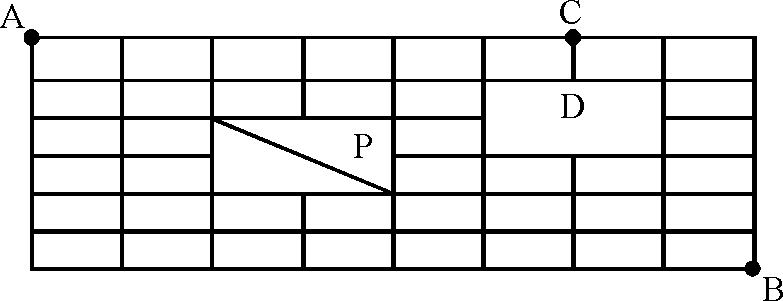 |
10. From A to B = 90 paths
From B to C via N = 6 (and not via M) From B to C via M = 7 paths In all 90 x (6 + 7) = 1170 paths Hence, [1].
11. We have f(x)f(y) = f(xy)
A f(1)f(1) = f(1 x 1) = f(1)
f(1)2 = f(1)
f(1) = 0 or f(1) = 1
If f(1) = 0 then f(x) = 0 for any x x = x x 1 f(1) = 1 Now, f(2) = 4
So, i - f(1) - f|j x2] . f[2) f(2) . f[i] x 4
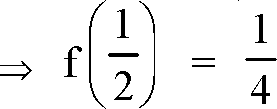 |
|
Hence, [2]. |
12. From the definition of Seed, it is clear that we have to count number of integers between
1 and 500, which are divisible by 9.
The smallest is 9 and the largest is 495.
9x1 = 9 and 9 x 55 = 495.
Hence there are 55 such numbers.
Hence, [5].
13. Let a = AB, b = AC, c = BC
abc
A (AABC) = '4R
1
Also, A( A ABC) = - x c x 3
abc 1
- = x c x 3
4R 2
a x b
R = TTT
2 x 3 17.5 x 9
2
= 26.25 cm
2 x 3 Hence, [5].
14. Let the three sides be a = 8, b = 15 and c = x Case I:
c is the longest side.
we know that 15 < c < 23. (8 + 15 = 23) also for c = 17 we get a right angled triangle. Hence c should be > 17 for an obtuse angle.
Therefore c is 18, 19, 20, 21 or 22.
Case II:
b is the longest side. In this case 7 < c < 15 (. 15 - 8 = 7) also for a right angled triangle
c < V161 s 12.7 .-. c can be 8, 9, 10, 11 or 12.
Hence in total there are 10 possible cases.
Hence, [3].
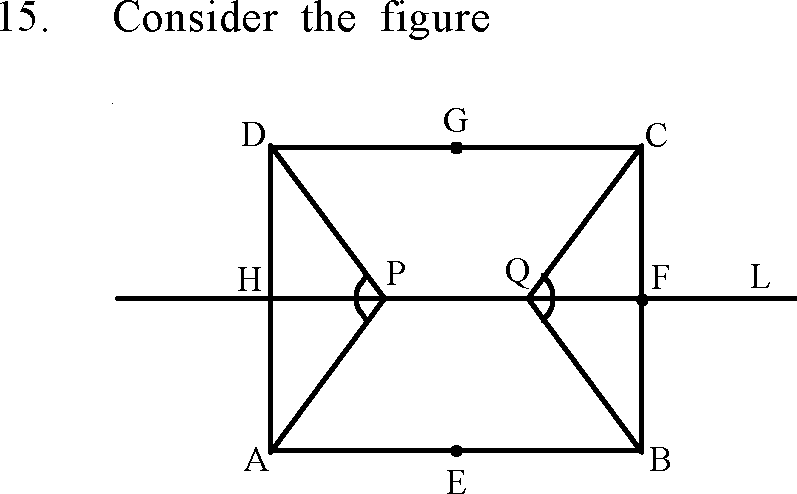
m Z APD = m Z BQC = 120
Hence m Z HAP = 30 & m Z HP A = 60
x
Let AH = x. HP =
1 x x2
A( APHA) = -x xx-3 = 23 = A( A PHD)
= A( A QFB) = A( A QFC)
2 o 2
x 2x
... A( A APD) + A( A BQC) = 4 x = 3 A(dABCD) = 4x2
2x2 (4V3 - 2)x2
Area of ABQCDP = 4x2 -
V3
Required Ratio = -2- = 2JJ - 1.
2x
VT
Hence, [5].
16. (a + b + c)1 has each term of the form axbycz where x + y + z = 20. This has 20 + 2C2 = 231 solutions.
Hence, [1].
17. There are 3 possibilities
|
Horse |
Rank | ||
|
Case 1 |
Case 2 |
Case 3 | |
|
Red |
4/5 |
4/5 |
3 |
|
White |
2 |
3 |
4/5 |
|
Black |
5/4 |
1 |
2 |
|
Grey |
1/3 |
2/4/5 |
1/4/5 |
|
Spotted |
3/1 |
2/4/5 |
1/4/5 |
From the above table, we get 17-[4] 18-[3]
20. From statement A alone we get various possible cases. We can see that 7 rounds have to be played. The bye could have occured in any of the first 6. Acordingly the totals could be:
REP*
SET-222
|
Round |
Bye in | |||||
|
Round 1 |
Round 2 |
Round 3 |
Round 4 |
Round 5 |
Round 6 | |
|
1 |
127 |
126 |
124 |
120 |
112 |
96 |
|
2 |
64 |
63 |
62 |
60 |
56 |
48 |
|
3 |
32 |
32 |
31 |
30 |
28 |
24 |
|
4 |
16 |
16 |
16 |
15 |
14 |
12 |
|
5 |
8 |
8 |
8 |
8 |
7 |
6 |
|
6 |
4 |
4 |
4 |
4 |
4 |
3 |
|
7 |
2 |
2 |
2 |
2 |
2 |
2 |
From Statement B alone, we cannot say anything as other players too might have recived byes. From both together we can say that the number of players is 124. Hence, [4].
21.
|
A |
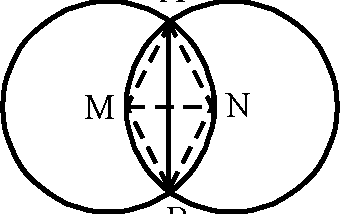 |
Area required region
= 2 x [(Area of sector N - AMB) - A( A ANB)] 120
= 2 x
360
= -n x 12 - 2 x A( A AMN)
2 V3
= -n - 2 x x 1
3 4
2503
22.
|
A |
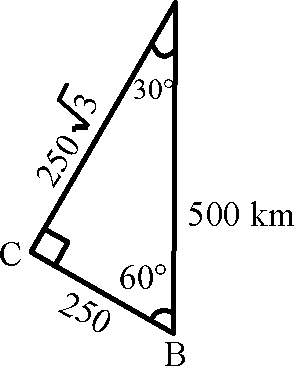 |
Time required to travel from A to C =
70 6.1 hrs 6 hrs 11 mins
250
Time required to travel from B to C = -50 = 5 hrs.
Rahim should reach at C before (8:00 + 5 hrs - 15 minutes) i.e., 12:45 p.m. Rahim should leave place A before (12:45 - 6 hrs 11 mins) i.e., 6:34 a.m. Hence, [2].
Vi44 = 3 + 4 + 5
So, the numbers are 3, 4 and 5.
Hence, [1].
24. In the given sum,
,11 9 3 1
1+12+F = H =7 = 2 -2
_ 2 7 _ 8 _ 1 = 2 + 6 = 3 = 3 - 3 Similarly,
20072 20082
= 2008 -
1
2008
Hence, [1].
REP*
SET-222
25.
|
A |
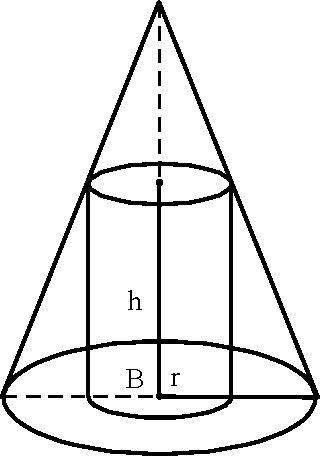 |
|
A |
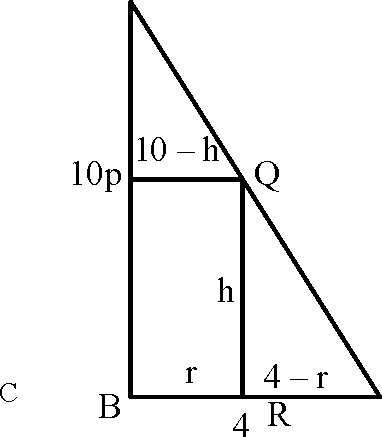 |
AP
PB
BR
10 - h h
r
RC QC 10 - h
4 - r
r
4h = 40 - 10r
h 4 - r 2h = 20 - 5r Surface area of cylinder = 2 n r2 + 2 n rh = 2nr2 + nr (20 - 5r)
= 20 nr - 2 nr2
So, we have to maximize f(r) = 20r - 3r2 (n is constant)
Differentiating, we get, f'(r) = 20 - 6r 10
f'(r) = 0 r =
and f "(r) = -6 <0
10
T
So, f(r) has a maxima at r
10 I 100n
1 3 ,J =
Hence, [1].
Answers to questions 26 to 28:
From statements (vii), (viii) and (ix), we get, PUS Orange
R Q
Yellow Green Then, T is opposite S and the colour of S is red.
From (x), the colour of house P is white, hence the colour of house T is blue.
|
P |
U |
S |
|
White |
Orange |
Red |
|
R |
Q |
T |
|
Yellow |
Green |
Blue |
Now, from (v) and (x), we get
T > S, Q > P > R
From (vi), U is the shortest.
i.e., the order of houses in the descending order of their heights is T, S/Q, Q/S, P, R, U.
26. R is yellow coloured house and the house diagonally opposite R is S. And the colour of house
S is Red. Hence, [4].
27. The second tallest house is either S or Q. Hence, [5].
28. The tallest house is T and its colour is blue. Hence, [2].
29. Let the volume of data transfer in India and Singapore be y, each, then
For India : T , , x 100 = 9 Total revenue = 100y = 11.11y
Total revenue 9 J
9y 900y
For Singapore : , , x 100 = 21 Total revenue = = 42.85y
Total revenue 21
Hence, [5].
30. Revenue from data transfer as a percentage of total revenue in 2010: For India = 3 x 9% = 27%
For Sweden = 2 x 18% = 36%
Total revenue in 2010:
In India = 2 x In Sweden (say x)
In 2010, the volume of the data transfer in each country be y.
ARDT in Sweden in 2010 = $6 (same as in graph)
6y 6x
it x 100 = 36 - y = 100
Let ARDT in India in 2010 be z, then
6x
zy z X-
~r~ x 100 = 27 100 x 100 = 27 2x 2x
z = $9
The required percentage increase
9 - 1
= ~Y~ x 100 = 800%.
Hence, [3].
31. We know that ARDT X volume = % of total revenue
Total revneue
i.e., we want a pair for whom the ratio
% of total revenue
is approximately same for both.
ARDT
54 19
Option [1]: Philipines = ; Austria = , not same
3 8
13 22
Option [2]: Canada = ; Poland = ; not same
8 6
25 17
Option [3]: Germany = ; USA = ; not same
6 11
12 17
Option [5]: Denmark = ; Mexico = ~, not same.
6 3
Hence, [4].
Answers to questions 32 to 34:
Sectional cut-offs for colleges 1, 2, 3, 4, 5 and 6 are mentioned in the table given in the question.
The sections where cut-offs are missing need not be considered.
32. To get calls from all colleges, Bhama should score marks equal to maximum cut-off marks required for each section of all the colleges the Bhama should score,
|
Section A |
Section B |
Section C |
Section D |
|
45 |
45 |
46 |
45 |
Aggregate marks obtained = 45 + 45 + 45 + 46 = 181. Hence, [2].
33. If aggregate marks of Charlie are 175, Charlie stands a chance to clear cut-off of college 2 and 3.
So, Charlie should score,
|
Section A |
Section B |
Section C |
Section D |
|
50 |
50 |
50 |
25 |
His aggregate marks = 50 + 50 + 50 + 25 = 175. Hence, [3].
34. Aditya did not get a call from even a single college and if he has score maximum aggregate marks, he must have cleared cut-off of two sections with highest score and not cleared the remaining two. So,
Aditya should have scored,
|
Section A |
Section B |
Section C |
Section D |
|
50 |
50 |
41 |
43 |
Aggregate marks = 50 + 50 + 41 + 43 = 184. Hence, [3].
Answers to questions 35 to 38:
REP*
SET-222
Stage I:
B lost at least one match. D and E lost one match each.
C and F have lost two matches each.
i.e., A is the top team of Stage I and has won all the three matches in Stage I.
Hence, A and F did not play against each other in Stage I.
Also, B, D and E have won at least one match. Hence, C and F must have lost all the 3 matches in Stage I.
Thus, the 9 matches played in Stage I are:
E(Lost) x B(Won) E(Won) x C(Lost) E(Won) x F(Lost)
A(Won) x B(Lost) A(Won) x C(Lost) B(Won) x F(Lost)
D(Won) x C(Lost) D(Won) x F(Lost) D(Lost) x A(Won)
Stage II:
The 6 matches played in Stage II are as follows:
|
A x E |
B x C |
D x E |
|
A x F |
B x D |
C x F |
The leader of Stage I i.e., A lost both his matches.
Two teams at the bottom after stage I are C and F.
Since, F lost against A, F lost against C also.
And C won against B and F.
Now, the only other team that lost both the matches is D.
A(Lost) x E(Won) A(Lost) x F(Won)
B(Won) x C(Lost) B(Won) x D(Lost)
D(Lost) x E(Won) C(Lost) x F(Won)
35-[2] 36-[4] 37-[5] 38-[5]
39. Percentage growth rate of 2007(over 2006)
= 31.6% = 30%
The subscription in Europe in 2008 = 1.3 x 500 = 650 The difference = 650 - 610 = 40 The closest option is [1].
Hence, [1].
40. Let there be 100 subscribers in Europe in 2003. In Europe
| ||||||||||||||||||||||||||||||||||||
|
Hence, [1]. | ||||||||||||||||||||||||||||||||||||
The annual percent change in the gap between the subscription revenues in the US and Europe during.
41.
340 - 300 300
270 - 320 320
210 - 270 270
110 - 180 180
100 - 110
40
300
50
320
60
270
2003-04 :
2005-06:
2006-07:
70
180, the highest.
2008-09:
10
110
2009-10:
190
Hence, [4].
42. Growth rate of 2007(over 2006) 500 - 380
x 100 = 31.6% = 30%
380
Growth rate of 2005(over 2004) 270 - 180
x 100 = 50%
180
50 - 30
The percentage change = 5 x 100 = 40%,
which is closest to 35. Hence, [3].
Answers to questions 43 to 47:
Abdul - A, Bikram - B, and Chetan - C
|
A |
B |
C | |
|
10:00 AM |
Purchase all at a time |
Purchases x shares |
Purchases shares worth Rs.y |
|
11:00 AM |
- |
Purchases x shares |
Purchases shares worth Rs.y |
|
12.00 noon |
- |
Purchases x shares |
Purchases shares worth Rs.y |
|
1:00 PM |
- |
Purchases x shares |
Purchases shares worth Rs.y |
|
2:00 PM |
- |
Purchases x shares |
Purchases shares worth Rs.y |
|
3:00 PM |
Sells all at a time |
Sells all 5x shares |
Sells all shares |
Profit or loss = |(sale value at 3 pm) - (investment in purchase)|
Profit or loss
Return = - x 100
Investment
43. Consider following two cases of the fluctuating prices of shares of company XYZ.
|
Case I |
A |
B |
C |
Case II |
A |
B |
C | ||
|
10:00 AM |
10 |
5 shares |
1 share |
Rs.20 |
20 |
5 shares |
1 share |
Rs.20 | |
|
11:00 AM |
20 |
1 share |
Rs.20 |
10 |
1 share |
Rs.20 | |||
|
12 noon |
10 |
1 share |
Rs.20 |
5 |
1 share |
Rs.20 | |||
|
1:00 PM |
20 |
1 share |
Rs.20 |
20 |
1 share |
Rs.20 | |||
|
2:00 PM |
10 |
1 share |
Rs.20 |
10 |
1 share |
Rs.20 | |||
|
Total investment |
Rs. 50 |
Rs.70 |
Rs.100 |
Rs.100 |
Rs.65 |
Rs.100 | |||
|
No. of shares |
5 |
5 |
8 |
5 |
5 |
10 | |||
|
Closing price |
20 |
5 x 20 = 100 |
5 x 20 = 100 |
8 x 20 = 160 |
30 |
5 x 30 = 150 |
5 x 30 = 150 |
10 x 30 = 300 | |
|
Returns 100 |
50 = 1 50 |
30 = 0.43 70 |
6 = 0.6 100 |
1 II 0. 5 |
85 < 2 65 |
200 2 100 = |
In case I, Abdul got maximum Returns while in
Case II, Chetan got maximum Returns. Thus, we cannot determine the trader gaining maximum returns. Hence, [5].
44. Refering to case II, statement [1], [3] and [4] cannot be always true. Consider case III,
|
Case III |
A |
B |
C | |
|
10:00 AM |
10 |
5 shares |
1 share |
Rs.99 |
|
11:00 AM |
9 |
1 share |
Rs.99 | |
|
12 noon |
11 |
1 share |
Rs.99 | |
|
1:00 PM |
9 |
1 share |
Rs.99 | |
|
2:00 PM |
1 share |
Rs.99 | ||
|
In Total Investement |
Rs.50 |
Rs.50 |
Rs.495 | |
|
No. of Shares |
5 |
5 |
49.9 | |
|
Closing Price |
12 |
5 x 12 = 60 |
5 x 12 = 60 |
49.9 x 12 = 598.8 |
|
Returns 100 |
10 = 0.2 50 |
10 = 0.2 50 |
103 . 8 = 0 2 495 |
As in Case III, Returns of Bikram and Chetan can be equal, Statement II cannot be always true. Hence, [5].
45. Consider case IV:
| ||||||||||||||||||||||||||||||||||||||||||||||||||
|
Thus, Bikram earns minimum Return. Hence, [1]. |
|
10:00 AM |
11:00 AM |
12 noon |
1:00 PM |
2:00 PM |
3:00 PM | |
|
Share price |
a |
b |
c |
d |
e |
f |
From (i) a > f Consider Emily invests Rs.x.
Answers to questions 46 and 47:
46.
REP*
SET-222
xx At 10 am, Emily purchased _ shares, sold at 12 noon for Rs._ x c
a a
xc xc
At 1 pm, Emily purchased shares, finally at 3 pm earned Rs._r x f.
ad
ad --- (1)
--- (2)
xcf
cf
__________ c a
From, (ii) x < 7- 1 < > >1 ad ad d f
Dane made profit implies
(d + e + f) - (a + b + c) > 0 From (1)
(f - a) < 0 (d - c) < 0
(e - b) >0 (for (2))
i.e., e > b and e < f ... from (iii)
Thus, a > f > e > b and a > c > d
Thus, share price was highest at 10 am. Hence, [1].
47. Refering to answer to 46, c > d therfore, statement (4) is false.
v e is not lowest share price, statement (1) is also false. Thus [1] and [4] both are right answers.
48. Gross pay of HR department = 5000 x 1.7 x 5 = 42500 Average gross pay = 8500
Gross pay of a new person in HR department = 8000 x 1.9 = 15200 Total new gross pay of HR = 57700 New average = 9617
, 9617 - 8500 ,n/
Percentage change = - x 100 = 13%
8500
Hence, [3].
49.
HR Marketing Finance
z years x years
20 x 30 - x + y For Finance : -- =31
x - y = 20 ... (i)
30 x 35 - y + x - z For Marketing: -- = 35
x - y + z = 35 ... (ii)
Form (i) and (ii), z = 15
45 x 5 + 15 240
Average age for HR = --- = = 40
years
66
Hence, [3].
50. Current average basic pay of HR department = 5000 New average basic pay of HR department
5000 x 5 + 2 x 6000 + 8000 45000 = --- = = 5625
625
Percentage change = 5000 x 100 = 12.5% Hence, [2].
51. In sentence A, there is a spelling error. Imigrant is not the correct spelling, immigrant is the correct spelling. Sentence C has a punctuation error, as it requires a comma at the end. Sentence D needs the article the before owner of dry goods business. Sentence E has a tense error: it should be would later become, not would later became. So only B is correct. Hence, [1].
52. Sentences A and D are correct. Sentence E uses a wrong article: it should be an industry, not a industry. The comma at the end of sentence C is incorrect, as it separates the subject from the main verb. B uses the incorrect pronoun their instead of its. Hence, [4].
53. In sentence B, the word home should be in the plural, as millions of people cannot share a single home. In E, the verb should be the singular has, because the subject death count is singular. A, C and D are correct. Hence, [4].
54. In B, the verb associate should be in the past tense in keeping with the rest of the sentence. Similarly in C, seem should also be in the past. In E, the noun effort is missing an article. Therefore only A and D are correct. Hence, [5].
55. In the 1st sentence brooch, which means a clasp or ornamental pin is the correct word. Broach is a verb which means to bring up a topic for discussion. In the 2nd sentence councillor, which means a member of a council is the best fit, as people do not complain about the amenities in the neighbourhood to a counsellor (a person who counsels; adviser) but to a councillor who can handle these issues. The 3rd sentence requires a noun, which is advice and not advise which is a verb. In the 4th sentence, climactic means pertaining to or coming to a climax which suits in the context of the play. Climatic means of or pertaining to climate, which does not fit in the context. In 5th sentence, flare which means a shape that spreads outward is the correct option. Flair, which means talent, is incorrect. Only [3] in the options has all the sequence BAAAB. Hence, [3].
56. In the 1st sentence currants, which means small seedless raisins used in baking, fits best in the context of making a cake. In the 2nd sentence exceptionable, which means objectionable, is the best fit in this context. In the 3rd sentence to consent to is the correct expression. In the 4th sentence, obliged, meaning required or constrained as by law, suits the context. In the 5th sentence, sanguine which means cheerfully optimistic or confident fits the sentence. Genuine is incorrect because something can be either genuine or not, not too genuine. Only [2] has the required sequence BBAAA. Hence, [2].
57. In the 1st sentence caustic, which means severely critical or sarcastic, fits in the context. In the 2nd sentence cogent, which means pertinent is the appropriate word in the context. In the 3rd sentence, averse, meaning having a strong feeling of opposition, is the correct word in the context. In the 4th sentence, coupe, which means the compartment in a railroad car fits in the context. Peal, which means to sound loudly and sonorously fits in the context of the 4th sentence. Only option [2] has the sequence BBBAB. Hence, [2].
58. In the 1st sentence diffusing, meaning spreading about, fits in the context. In the 2nd sentence,baited, which means tormented fits in the context of asking irrelevant questions. In the 3rd sentence, horde, which means a large group or crowd, fits in the context. In the 4th sentence, internment which means confining someone in a prison fits the sentence. In the 5th sentence, unsociable is the appropriate word and means not congenial. The correct sequence is BABBA.
Hence, [1].
59. Sentences [1], [2], [4] and [5] use the word run appropriately. Sentence [3] makes no sense, because run over usually means to hit and knock down, especially with a vehicle. Hence, [3].
60. Sentences [1], [2], [3] and [4] use the word round in appropriate contexts. In sentence [5] the correct expression should be come around and not come round. Hence, [5].
61. The word buckle has been used in correct contexts in sentences [1], [3], [4] and [5]. In sentence
[2], broke into a buckle does not make any sense. Hence, [2].
62. Sentences [1] and [2] use the word file in the most common context. Sentences [3] and [4] also use the word correctly. However, [5] should be broke the ranks and not broke the file. Hence, [5].
63. Disingenuous means insincere and this best fits the context as the phrase ethnic cleansing is marked by apostrophes indicating a misrepresentation. Also, the word victims is best in contrast to perpetrators. Hence, [3].
64. Navigators, calendar makers are best clubbed under the category of observers rather than scrutinizers, as the latter term is more used to refer to specialists in a particular field. Students can also fit to a certain extent and this leaves us with options [2], [4] and [5]. Concede has more to do with defeat or revision which is more apt in this context than agree or conclude. Hence, [4].
65. Since the sentence talks about the life of an individual extending from the first few days to the entire term of his/her life, genetic endowments suits the context best. The closest option congenital relates to endowments happening at birth and this might not be as pertinent, viz.
the entire life-span of an individual. Pedagogy, which refers to education, fits in the second blank. Hence, [5].
66. The first word should combine well with the phrases central and education and propaganda. The first blank is not easy to resolve as many of the options fit in some way or the other. The second blank, however, is easier to resolve as the phrase earlier kind of world combines well with the word tradition. This leaves us with [4], which has the word organs, which suitably fits the first blank. Hence, [4].
67. The paragraph talks about how the hands of the doctor, Perowne, seem to be so important for the patients. It ends with how a certain category of people demonstrate signs of deserting the doctor. Option [3] says Perowne is not concerned but Perownes concern or the lack of it, cannot be determined as his views on this matter (patients leaving) are not stated. Option [2], however, states that the other category of people, who stick to Perowne, do so because they are not aware of their alternatives. This option sticks to the condition of a surgeons hands being important to his impression as a surgeon and continues with the thought of how Perowne is only chosen by default. Hence, [2].
68. The paragraph discusses climate change being disguised as a reason to implement trade protectionism by powerful industrialized countries. It ends by quoting the example of OECD countries citing lacklustre economic performance and the rapid rise of China and India for trade protectionism. Option [1] is not right as it does not mention the actors involved (evoked by whom?). Option [5] incorrectly states that all those who are climate change champions are perpetrators of global economic inequity. Option [3] relates climatic change to the rise of India and China, while the rise of these countries have only been mentioned viz. OECD countries. This leaves us with options [2] and [4]. Option [2] just talks of OECD countries so option [4], being more comprehensive, is a better ending to the passage. Hence, [4].
69. The paragraph discusses Mattancherry, Indian Jewrys most famous settlement. It goes on to describe the settlement in some detail and ends with an image of religious tolerance. So it makes sense that religious tolerance in some way should continue to complete the paragraph. This make option [5] irrelevant. Option [4] goes against the logic of the passage. Option [1] states peaceful coexistence, but coexistence with whom cannot be inferred. It seems that Mattancherry, an almost idyllic settlement, could have only been possible if this particular community wasnt discriminated against and left to its own devices. Hence, [2].
70. To paraphrase the passage, we can say: it is hard to pin down, intellectually, what singularly is a Western or Eastern thought. Option [3] changes the focus. Option [4] goes against the logic of the paragraph. Option [2] also goes against the grain of the passage. Between [1] and [5], refers more directly to the last sentence oft paragraph, and therefore completes the theme. Hence, [5].
71. Option [1] can be inferred from the first sentence of paragraph 5. The authors description of the way in which some of his friends enjoyed two two-cent ice creams at the same time, helps us infer [2]. According to the author, the act of enjoying the ice creams was almost like a celebration. Refer to paragraph 6 ... the consumer civilization pretends to give more ...what is worth four cents - option [4] is mentioned. Option [5] is clearly stated in the first sentence of paragraph 6. Option [3] cannot be inferred because the author mentions in the fourth paragraph that the justification provided by elders was mendacious or false. Hence, [3].
72. The word parvenu means upstart, i.e., a person who has risen suddenly from a humble position to a position of wealth or consequence, but who has not yet gained the manner associated with this new position. In the passage little parvenus refers to people who splurge inappropriately. Hence, [4].
73. Option [1] contradicts what is said in the passage, and [5] cannot be inferred at all. While
[3] and [4] may be partially correct, the most comprehensive reason is [2], i.e. intemperance, which means lack of moderation or excessive indulgence. Refer to paragraphs 3 (sumptuously enviable) and 5 (two ice creams suggested excess). Hence, [2].
74. Refer to the last two paragraphs. The penultimate paragraph begins with the quoted sentence, and the example given in the last paragraph clearly indicates that the concept of morality has changed over the years. Options [1] and [3] are exaggerations, and [4] and [5] are outside the purview of the passage. Hence, [2].
75. Refer to the last sentence of paragraph 4: the author thinks that the real reason his elders refused to allow him two ice cream cones at once was cruelly pedagogical, i.e. one intended to teach him something - in other words, didactic. Note that the author thinks that [2] cannot possibly be the reason, and the other options are completely out of context. Hence, [1].
76. The author starts the passage by negating the popular view of language as stated in option [1] and [3]. He then goes on to explicitly negate [2] in paragraph 2. [4] is also stated in the same paragraph. However, in paragraph 1, he states that [5] is the belief of some cognitive scientists, not of people in general. Hence, [5].
77. The spider-web analogy emphasizes the authors point that language is an instinct in human beings, not something that has to be consciously taught or learnt. Options [1], [3], [4] and [5] all pertain to animals doing something they have learnt or been trained to do. Only [2] pertains to an animal instinct. Hence, [2].
78. Refer to the last sentence of paragraph 2: option [2] is explicitly stated. On the other hand, [1], [3] and [4] are either not stated at all, or cannot be inferred to be unique to human beings. Hence, [2].
79. Refer to the first paragraph. According to the author, language develops in the child spontaneously. This indicates option [1] as the answer. Hence, [1].
80. Option [1] is a minor point, and [5] is not mentioned anywhere. [2] and [3] are only partially correct. Only [4] is the main idea that the author tries to convey through the passage. Hence, [4].
81. Refer to paragraph 2, the first sentence, where option [1] is clearly stated in the context of Rwanda and Haiti. [2] is mentioned only later in the paragraph, while the other options are not mentioned at all. Hence, [1].
82. Anthropogenic means caused or produced by humans. Therefore only option [4] conveys the correct meaning. Hence, [4].
83. Refer to the second half of the 3rd paragraph: option [3] is clearly mentioned as treason the drought at the time of the Maya collapse had a different impact. Hence, [3].
84. Refer to the first paragraph: according to the author, Maya archaeologists still have different opinions as to what caused the Maya collapse, and which reason was most important. This implies [4] as the answer. Options [1], [2] and [3] cannot be inferred, and is irrelevant. Hence,[4].
85. Options [1] to [4] have been mentioned in the course of the passage. [5] distorts the information in the passage: only the kings and nobles have been mentioned as being focused on short-term concerns, and not the entire Maya population. Hence, [5].
86. Refer to paragraph 1, the sentence Many of the concepts of modern art ... certain times and certain places. [3] is a paraphrase of the same. Hence, [3].
87. Options [1] and [3] contradict the positive attitude of the author towards fossils and their worth. [4] is too literal. The word historic in [2] is misleading, as it implies a significant event, which is not necessarily what the author implies. Only [5] appropriately encapsulates the metaphorical meaning of the word fossil as it is used in the passage. Hence, [5].
88. Refer to paragraph 1, the second sentence, where option [1] is clearly stated. Hence, [1].
89. Refer to paragraph 1, the sentences Briefly then ... spiritual experience. This is what is summarized in option [4]. [2] and [3] are only partial answers, [1] is irrelevant, and [5] is not mentioned at all. Hence, [4].
90. Refer to the last paragraph, the last two sentences. Options [1] and [4] contradict what is stated in the passage. [2] and [3] are incomplete, as they neglect to mention how the past influences can be shaped to meet present needs. Only [5] covers all these points. Hence, [5].
22
From statement B alone, we can draw no conclusion without knowing the number of rounds. With both the statements together, we can say that the champion plays 6 matches. Hence, [4].
Hence, [5].
|
Attachment: |
| Earning: Approval pending. |
